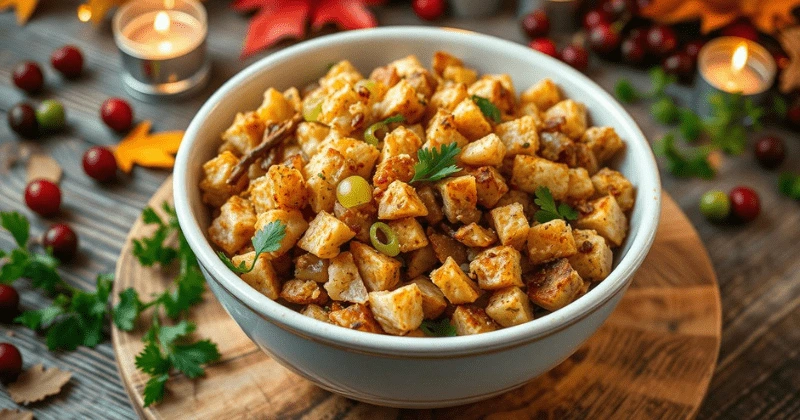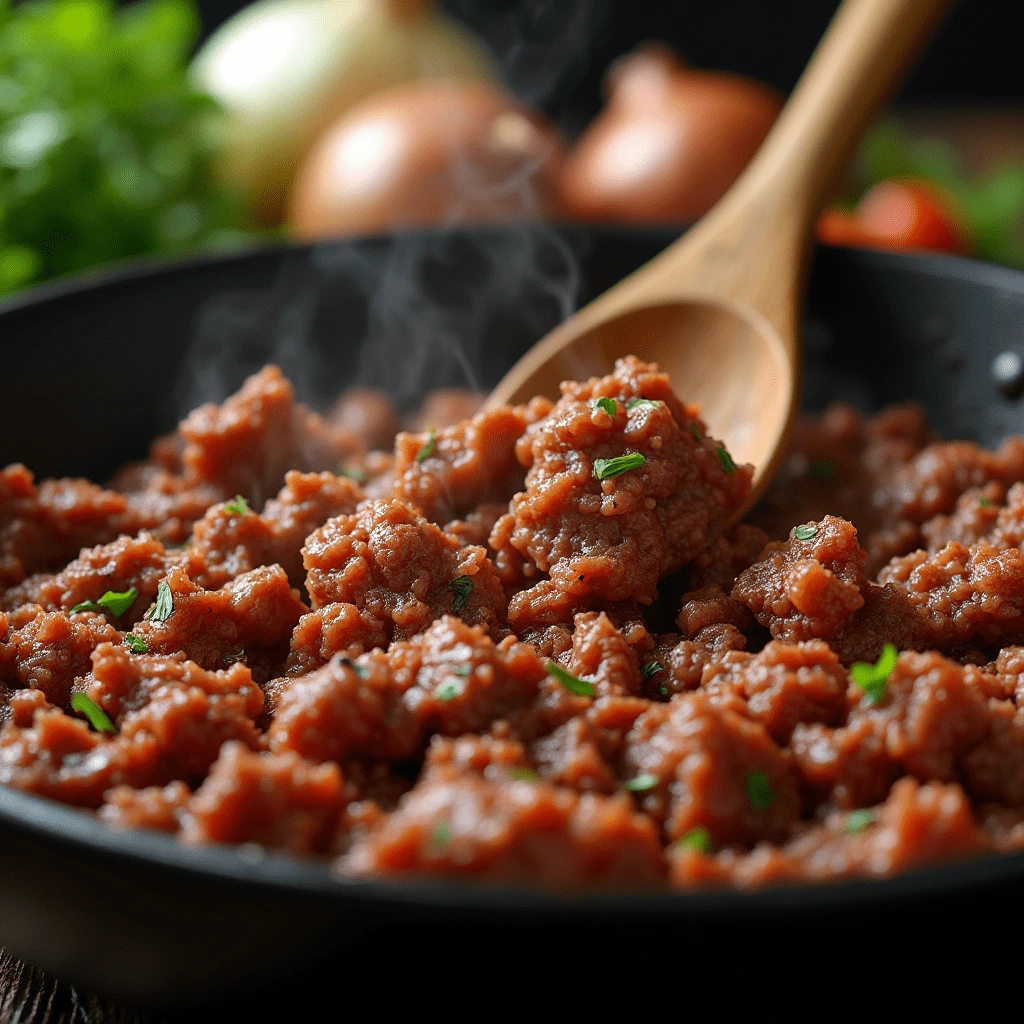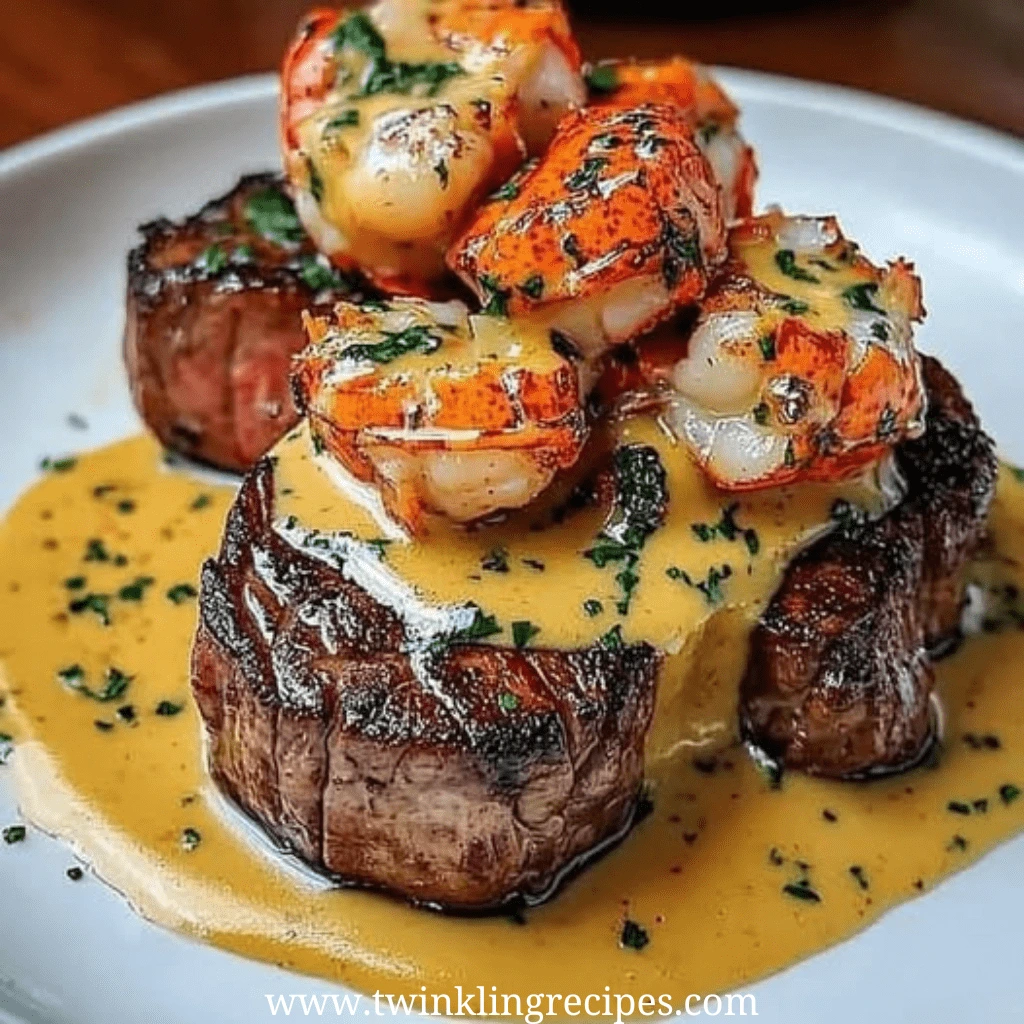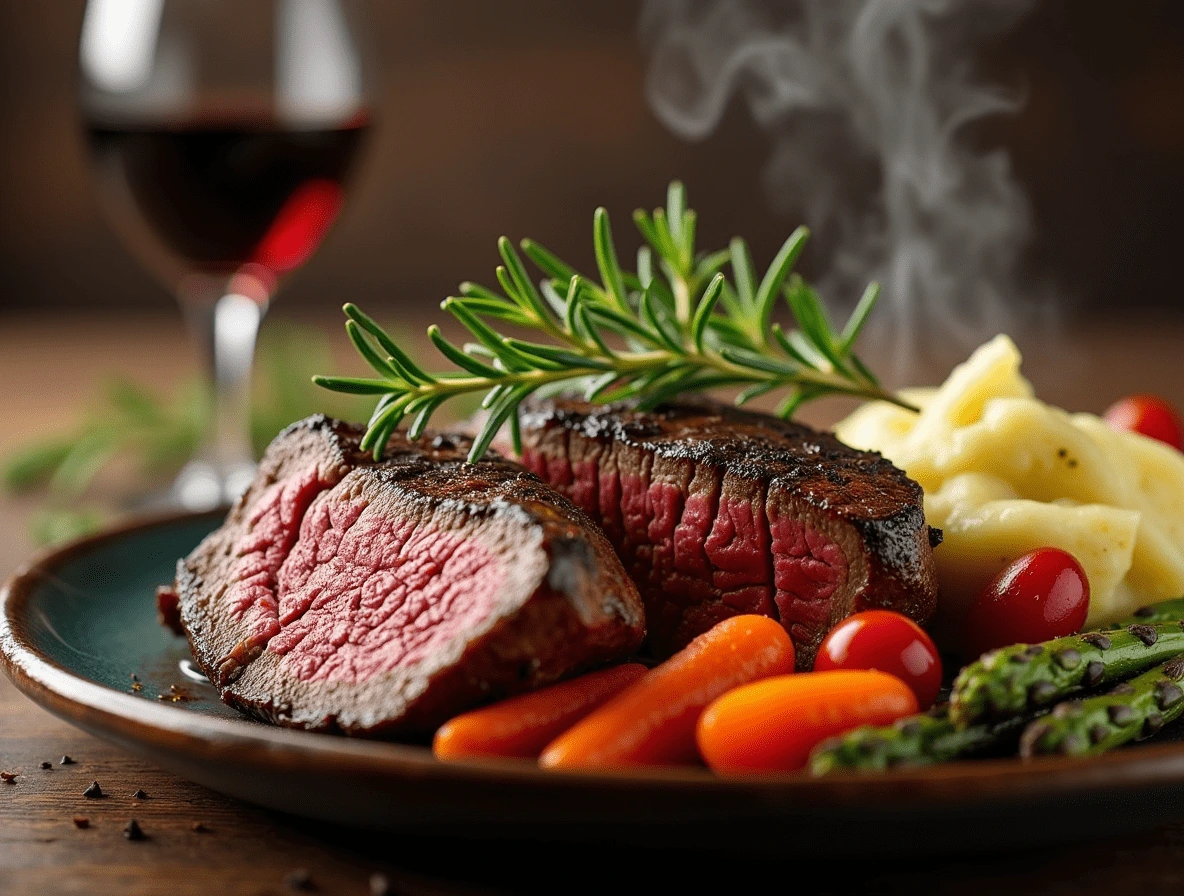As the crisp air of autumn fills the atmosphere, the anticipation for Thanksgiving grows. The turkey is just the beginning; the stuffing, with its rich history passed down through generations, is the true star of the feast. It is the heart of a great Thanksgiving, a symbol of joy and togetherness.
The smell of my grandmother’s stuffing would fill our home. It was a fragrant mix of herbs, butter, and texture that was a perfect match for the turkey. Each bite was a journey back to the cherished memories of her Thanksgiving, underscoring the role of this dish in creating lasting family traditions.
Table of Contents
Understanding Traditional Thanksgiving Stuffing
As you get ready for Thanksgiving, it’s key to know the difference between stuffing and dressing. Stuffing is cooked inside the turkey, while dressing is baked outside. Both are loved, but they have their ways of being made.
Stuffing vs. Dressing: What’s the Difference?
Stuffing mixes bread, herbs, veggies, and sometimes meat like sausage. It goes inside the turkey. Dressing, baked in a dish, has similar ingredients but a different feel and way of being made.
The Role of Stuffing in Thanksgiving History
Stuffing has been a Thanksgiving favourite for ages, with recipes shared in families. It shows the variety of American food, with each family adding their twist. The core of stuffing is a beloved part of the Thanksgiving meal.
| Stuffing | Dressing |
|---|---|
| Cooked inside the turkey | Baked separately in a dish |
| Tends to have a more compact, moist texture | Often has a drier, crumbly texture |
| May include meat, such as sausage or oysters | Typically omits meat, focusing on bread and vegetables |
| Absorbs flavors from the turkey | Develops its own distinct flavor profile |
“The smell of Thanksgiving stuffing brings back so many memories of my grandmother’s kitchen. It’s a tradition that connects us to our roots and the flavors of our heritage.”
Whether you like stuffing or dressing, both are key parts of Thanksgiving. As you plan your meal, consider the unique traditions and flavours of this dish.
Essential Ingredients for Perfect Turkey Stuffing
Making the perfect turkey stuffing is about picking the right ingredients. Whether you like a traditional bread stuffing or a sausage-filled one, choose quality and flavour. The must-haves for a great stuffing are:
- Bread: Choose sturdy bread like French or Italian. It soaks up flavours well.
- Butter: Rich, creamy butter is crucial for the stuffing’s taste.
- Celery and Onions: These add depth and a sweet, crunchy touch.
- Fresh Herbs: Sage, rosemary, thyme, and parsley give it that Thanksgiving flavour.
- Poultry Seasoning: A mix of spices like sage and thyme boosts the turkey’s taste.
- Broth: Chicken or turkey broth keeps the stuffing moist and savoury.
- Eggs: Eggs, if used, help the stuffing stick together.
Add ground sausage or cornbread for a bolder taste. The bread and seasonings you choose will shape your stuffing’s taste and texture.
“The secret to the perfect turkey stuffing lies in the balance of flavors and textures. With the right combination of bread, herbs, and savory elements, you can create a mouthwatering side dish that complements the Thanksgiving feast.”
Choosing the Right Bread for Your Stuffing
Choosing the proper bread is key to a great Thanksgiving stuffing. You can go for classic bread, cornbread stuffing, or a homemade recipe. The bread’s type affects the stuffing’s texture and taste.
Types of Bread to Use
There are many breads to choose from. Cornbread is sweet and crumbly, while sourdough adds a tangy flavour. Challah and ciabatta are also incredible, offering a light texture that absorbs flavours well.
Proper Bread Preparation Methods
- Cut the bread into 1-inch cubes and let them dry for about 48 hours, stirring occasionally. This makes the bread stale, which helps it soak up more liquid and seasonings.
- Or, dry the bread cubes in a low-temperature oven (around 200°F) for 20 minutes. This is quicker if you’re short on time.
Why Stale Bread Works Best
Stale bread is essential for the perfect stuffing texture. It can hold more liquid and flavours, making the stuffing cohesive and satisfying. Fresh bread, however, can make it soggy and dense.
“The bread should be diced into 3/4″ to 1″ cubes or torn into 1″ to 1 1/2″ pieces before using it in stuffing.”
Bread makes up about 90% of the stuffing. So, picking the proper bread and preparing it well are crucial for a delicious Thanksgiving feast.
The Secret to Flavorful Turkey Stuffing Recipe
Creating a delicious turkey stuffing for Thanksgiving is all about balance. You need fresh herbs, sautéed veggies, and seasoned bread. Start by sautéing onions and celery in butter. This creates a rich base for your stuffing.
Poultry seasoning, with its mix of sage, rosemary, thyme, and marjoram, adds depth. It’s important to get the bread-to-liquid ratio right. This ensures your stuffing is just right—not too dry or soggy.
- Start with 8 ounces (about 6 cups) of homemade garlic croutons for your stuffing. It serves 4 to 5 people.
- Melt four tablespoons (57g) of butter in a skillet. Sauté onions and celery until they’re soft and smell great.
- Add 1 ¾ cups (415ml) of chicken or vegetable broth. Mix in fresh herbs like sage, thyme, and parsley.
- Season with salt, pepper, and plenty of poultry seasoning. This brings out the traditional Thanksgiving flavours.
Following these steps, you’ll make a classic stuffing full of flavour and moisture. You can bake it in a dish or stuff it into your turkey. Either way, it’ll be the highlight of your Thanksgiving meal.
| Ingredient | Quantity |
|---|---|
| Homemade Garlic Croutons | 8 ounces (6 cups) |
| Butter | 4 tablespoons (57g) |
| Chicken or Vegetable Broth | 1 ¾ cups (415ml) |
| Fresh Herbs (Sage, Thyme, Parsley) | As desired |
| Poultry Seasoning | As desired |
| Salt and Pepper | To taste |
“The secret to a flavorful turkey stuffing lies in the perfect blend of fresh herbs, sautéed vegetables, and well-seasoned bread.”
Fresh Herbs and Seasonings Guide
Making the perfect Thanksgiving stuffing is all about finding the right flavours. At its core, a traditional stuffing recipe relies on fresh herbs and seasonings, which are crucial for making your homemade stuffing truly special.
Essential Herbs for Traditional Flavor
The classic herbs for Thanksgiving stuffing are sage, rosemary, thyme, and parsley. These herbs give the stuffing a unique taste and a warm, comforting smell. This smell is what makes the holiday season feel so special.
- Sage: Earthy, slightly peppery, and utterly essential for traditional stuffing.
- Rosemary: Piney, aromatic, and a perfect complement to the other herbs.
- Thyme: Earthy, slightly minty, and a lovely accent to the other flavours.
- Parsley: Fresh, bright, and a crucial herb for balancing flavour.
Seasoning Combinations and Measurements
A typical Thanksgiving stuffing recipe uses a mix of these herbs, often in poultry seasoning. This mix usually has about 1 1/2 tablespoons of herbs, depending on how much stuffing you make. Fresh herbs are more flavoured than dried ones, so adjust the amounts as needed.
Salt and black pepper are also key for a great homemade stuffing. The exact amounts depend on your taste and how much stuffing you’re making.
“The secret to a truly memorable Thanksgiving stuffing lies in the thoughtful selection and harmonious blending of fresh herbs and seasonings.”
Step-by-Step Preparation Instructions
Making the perfect Thanksgiving turkey stuffing is a cherished tradition. It needs careful attention to detail. Whether you like a classic recipe or something new, the secret to success is in the preparation. Let’s go through the steps to make a delicious homemade stuffing highlighting your holiday meal.
First, make sure your bread cubes are dry. Leave them out for 1-2 days or toast them at 250°F for 45-60 minutes, stirring now and then. Dry bread makes the stuffing light and fluffy.
Next, melt butter in a large skillet over medium heat. Cook your aromatics, such as onions, celery, and garlic, until they’re soft and smell great. This step adds a rich, savoury flavour to the stuffing.
After cooking the veggies, put them in a big bowl. Add the dry bread cubes, chopped herbs (like parsley, sage, rosemary, and thyme), and your favourite seasonings. Mix everything gently until the ingredients are evenly distributed.
For the perfect stuffing, it should be moist but not soggy. Add about 1/2 to 1 cup of chicken or vegetable broth. Don’t add too much, or it will be too heavy.
If you’re making an in-bird stuffing, fill the turkey’s cavity before roasting. Put it in a greased dish for a baked stuffing and spread it out. This way, the top gets a nice golden-brown crust.
| Ingredient | Amount |
|---|---|
| Bread cubes | 8 cups |
| Butter | 1/2 cup (1 stick) |
| Onion, diced | 1 cup |
| Celery, diced | 1 cup |
| Garlic, minced | 3 cloves |
| Fresh parsley, chopped | 1/4 cup |
| Fresh sage, chopped | 2 tablespoons |
| Fresh rosemary, chopped | 1 tablespoon |
| Fresh thyme, chopped | 1 tablespoon |
| Salt and pepper | To taste |
| Chicken or vegetable broth | 1/2 to 1 cup |
Following these steps, you’ll make a delicious homemade turkey stuffing recipe for your Thanksgiving. Enjoy the making and relish the tasty outcome!
Cooking Methods and Techniques
Choosing the proper cooking method is key to a great turkey stuffing for Thanksgiving. You can bake it in a dish or stuff it inside the turkey. Each way has its benefits and needs special care to get it just right.
Oven-Baked Stuffing Method
To bake stuffing, put it in a 9×13-inch dish. Heat your oven to 350°F and cook for 30-35 minutes. The top should be golden, and the inside should be 165°F. This way, the stuffing gets crispy on top and stays moist inside.
In-Bird Stuffing Guidelines
To stuff the turkey, fill the cavity with about 3/4 cup of stuffing for every pound of turkey. This lets the stuffing cook evenly without getting too dense. To keep it safe to eat, make sure the stuffing reaches 165°F.
| Cooking Method | Oven Temperature | Cooking Time | Internal Temperature |
|---|---|---|---|
| Oven-Baked Stuffing | 350°F | 30-35 minutes | 165°F |
| In-Bird Stuffing | Varies with turkey | Varies with turkey | 165°F |
For slow cooker fans, cook the stuffing on low for 6-8 hours. It should be hot and tasty by then. Always check with a meat thermometer to ensure the stuffing is cooked and safe.
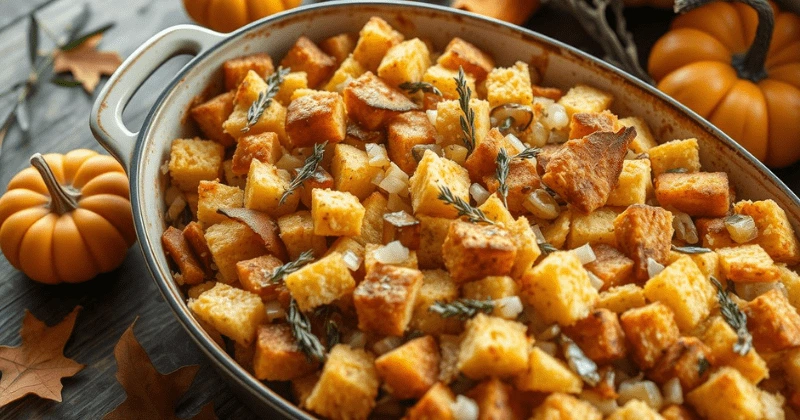
“The secret to a perfectly moist and flavorful turkey stuffing is all in the cooking technique. Follow these guidelines for the best results, whether you choose to bake it separately or stuff it right into the bird.”
Time and Temperature Guidelines
Getting your turkey stuffing right takes focus on time and temperature. Whether you bake it in a dish or inside the turkey, following the proper steps is key. This ensures it’s cooked safely and tastes excellent.
For a turkey stuffing recipe baked in a dish, use a 350°F oven. Cook for 30-35 minutes, until the top is golden and crispy. This method helps the stuffing get a nice texture and ensures it’s hot inside.
Cooking time for stuffing inside the turkey matches the turkey’s roast time. A stuffed turkey needs 45 minutes to an hour more than an unstuffed one. Use a meat thermometer to check the stuffing and turkey’s internal temperature, aiming for 165°F.
| Turkey Weight | Stuffed Cooking Time | Unstuffed Cooking Time |
|---|---|---|
| 10-12 pounds | 3¼-3½ hours | 2¾-3 hours |
| 12-14 pounds | 3½-4 hours | 3-3¾ hours |
| 14-18 pounds | 4-4¼ hours | 3¾-4¼ hours |
| 18-20 pounds | 4¼-4¾ hours | 4¼-4½ hours |
| 20-24 pounds | 4¾-5¼ hours | 4½-5 hours |
FoIn a slow cooker, how long do you cook the dressing? Cook on low for 6-8 hours, adjusting the time based on the amount of stuffing and desired texture.
For safety, always make sure the stuffing and turkey reach 165°F. With these turkey stuffing recipe tips, your stuffing will always be perfect.
Make-Ahead Tips and Storage
Preparing your ThanksgivingThanksgiving or homemade stuffing can save you a lot of stress. Here are some easy tips to help you get a head start on your holiday feast.
Preparation Timeline
Begin by cubing the bread 1-2 days before Thanksgiving. This helps the bread dry out, which is key for the right texture in your stuffing. Then, you can assemble the whole dish up to 24 hours before. Cover it and keep it in the fridge until it’s time to bake.
Storage Instructions
- Baked stuffing can stay in the fridge for up to 4 days. Just reheat it in a 350°F oven until it’s warm again before serving.
- If you want to store it longer, freeze the unbaked stuffing for up to 3 months. Thaw it in the fridge before baking, as usual.
Planning and using make-ahead options will make your Thanksgiving turkey or homemade stuffing fresh and delicious. It will also impress your guests on Thanksgiving Day.
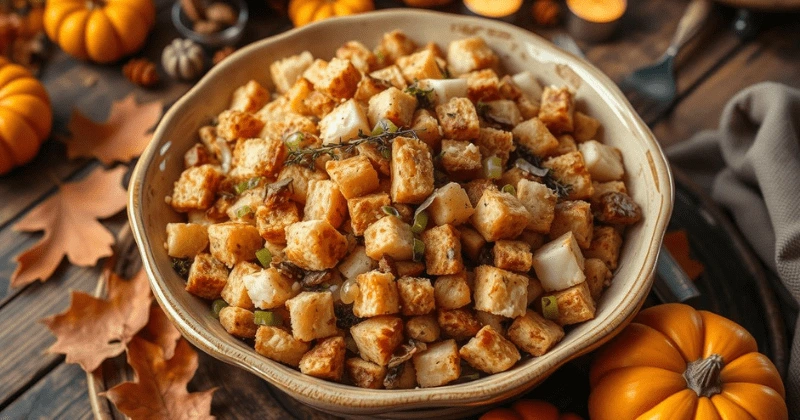
“The secret to the perfect Thanksgiving stuffing is all in the preparation. By getting a head start, you can enjoy the holiday with less stress and more time to savor the moment.”
Variations on Classic Stuffing
Thanksgiving dinner is not complete without stuffing. The traditional recipe is loved by many, but there are many other tasty options. Sausage stuffing adds a savoury flavour, while cornbread stuffing is sweet. Vegetarian stuffing is an excellent choice for those who don’t eat meat.
Gluten-free stuffing is perfect for those who need to avoid gluten. It’s made with grains like quinoa or rice-based breads. Some places even add oysters, chestnuts, or special sausages for a unique taste.
Try using different pieces of bread like whole wheat or sourdough to make stuffing with unique flavours. Many options exist, so feel free to experiment and find the perfect stuffing for your Thanksgiving.
“The beauty of stuffing is that it can be adapted to suit any dietary preference or regional tradition.”
| Stuffing Variation | Key Ingredients | Serving Size |
|---|---|---|
| Sausage Stuffing | Italian sausage, sage, thyme, onions, celery | 12 servings |
| Cornbread Stuffing | Cornbread, chicken broth, onions, celery, parsley | 10 servings |
| Vegetarian Stuffing | Mushrooms, kale, onions, garlic, vegetable broth | 8 servings |
| Gluten-Free Stuffing | Gluten-free bread, celery, onions, herbs, chicken broth | 10 servings |
Whether you choose to stick with tradition or try something new, the secret to a great Thanksgiving stuffing is finding the right mix of ingredients and cooking methods. It’s all about what you like and what fits your diet.
Common Mistakes to Avoid
Making the perfect turkey stuffing for Thanksgiving can be tricky. But, by avoiding common mistakes, you can achieve a delicious and well-textured turkey stuffing recipe and homemade stuffing.
- Fresh Bread vs. Stale Bread: Fresh bread can make the stuffing soggy. Use stale or day-old bread instead. It absorbs flavors better.
- Overmoisturizing: Adding too much broth or liquid can be a problem. Start with a little and add more as needed. The bread should be moist but not wet.
- Underseasoning: Season your stuffing well with herbs, spices, and other flavors. This is your chance to add delicious Thanksgiving smells.
- Overcrowding the Turkey: Don’t fill the turkey cavity too much. This can cause uneven cooking and safety issues. Leave some space.
- Premature Stuffing: Stuff the turkey just before roasting for safety. This prevents bacteria growth and ensures a well-cooked bird.
- Improper Temperature: Whether inside the turkey or in a dish, make sure the stuffing reaches 165°F. This kills harmful bacteria.
Avoiding these mistakes will help you make a delicious turkey stuffing recipe and homemade stuffing. Your Thanksgiving guests will love it. Happy cooking!
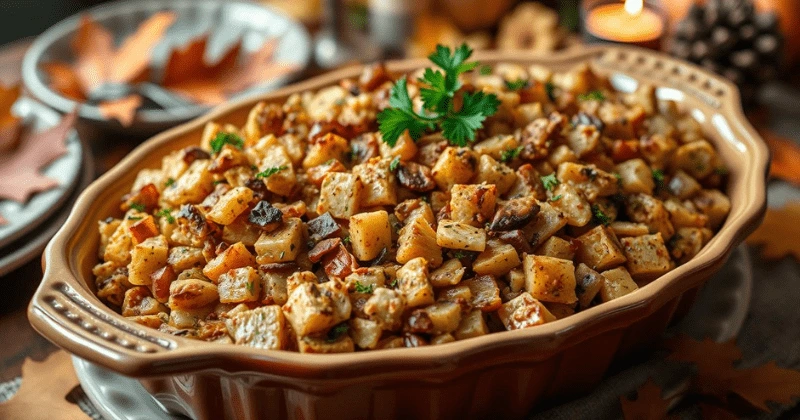
“The key to a successful Thanksgiving stuffing is paying attention to the details and steering clear of these potential mistakes.”
Serving Suggestions and Presentation
How you present your Thanksgiving or classic stuffing matters greatly when serving it. Here are some easy yet effective ways to make your dish stand out.
Garnishing Ideas
Add fresh herbs to improve the look of your stuffing. Sprinkle chopped parsley or sage leaves on top for colour and flavour. Add melted butter or turkey gravy for extra richness and moisture.
Plating Techniques
Use a large spoon or ice cream scoop to make your stuffing look neat. This helps you serve it evenly. For a personal touch, try serving it in muffin tins or ramekins. It creates crispy edges and looks great.
| Garnishing Ideas | Plating Techniques |
|---|---|
|
|
Using these simple tips, you can make your Thanksgiving stuffing or classic stuffing the highlight of your Thanksgiving meal.
Pairing with Other Thanksgiving Dishes
Thanksgiving wouldn’t be complete without the traditional turkey stuffing. It pairs well with many classic holiday dishes, whether it’s roast turkey, mashed potatoes, or green bean casserole. Your Thanksgiving stuffing will enhance their flavours.
The classic stuffing has a hearty, bread-based texture. It contrasts nicely with the moist turkey meat. The stuffing’s savoury flavours also balance the sweetness of sweet potato casserole or cranberry sauce, creating a perfect harmony at your table.
When seasoning your stuffing, think about the overall taste of your meal. Adjust the herbs and spices to match. This way, your stuffing will complement the other dishes, making your Thanksgiving feast unforgettable.
FAQ
What are the key ingredients in a traditional turkey stuffing recipe?
A classic turkey stuffing recipe includes bread, like French or Italian, and butter. It also has celery, onions, and herbs like sage and thyme. Poultry seasoning, chicken broth, and eggs are key too. Some recipes add sausage or use cornbread instead.
What is the difference between stuffing and dressing?
Stuffing goes inside the turkey, while dressing is baked outside. Both are often called the same thing, but the main difference is how they’re cooked.
How long has stuffing been a part of Thanksgiving traditions?
Stuffing has been a Thanksgiving staple for generations. Recipes are passed down, mixing bread, herbs, veggies, and sometimes meat. It shows family and regional tastes.
What type of bread is best for turkey stuffing?
Use heavy white breads like French or Italian. Sourdough and cornbread are also great. Cut the bread into 1-inch cubes and dry them for 48 hours. Stir them occasionally for the best texture.
What are the essential herbs for traditional turkey stuffing?
Sage, rosemary, thyme, and parsley are must-haves. Use 1 1/2 tablespoons of poultry seasoning for a mix. Fresh herbs add more flavor than dried ones.
What is the proper way to prepare and cook turkey stuffing?
Start by drying bread cubes. Sauté veggies in butter, then mix all ingredients in a bowl. Spread in a dish for oven-baked or fill the turkey cavity for in-bird stuffing. Cook until the center is 165°F.
How far in advance can you make turkey stuffing?
Dry bread cubes 1-2 days ahead. Assemble stuffing up to 24 hours before. Baked stuffing can be refrigerated for 4 days or frozen for 3 months.
What are some popular variations of turkey stuffing?
Try sausage, cornbread, or vegetarian stuffing. Use vegetable broth and skip the meat. Gluten-free options use gluten-free bread or quinoa.
What are some common mistakes to avoid when making turkey stuffing?
Don’t use fresh bread and avoid over-moistening. Season well and don’t overcook. Stuffing should be loosely packed in the bird for even cooking.
How should turkey stuffing be served and paired with other Thanksgiving dishes?
Serve stuffing hot, topped with fresh herbs. It goes well with turkey, cranberry sauce, mashed potatoes, and green bean casserole. Its savory taste complements sweeter sides.

